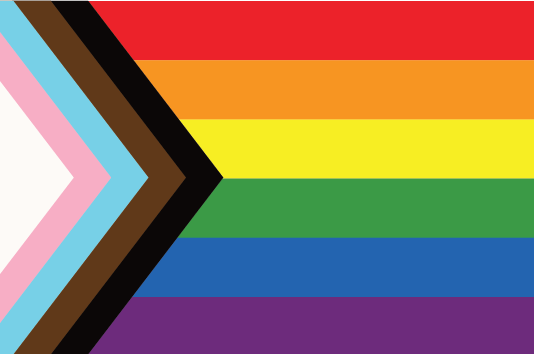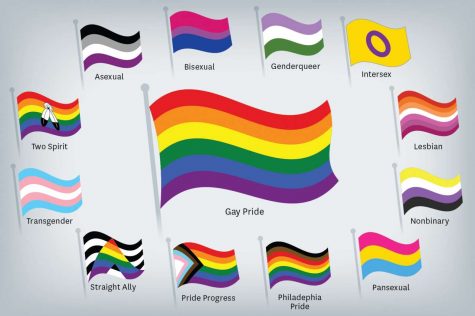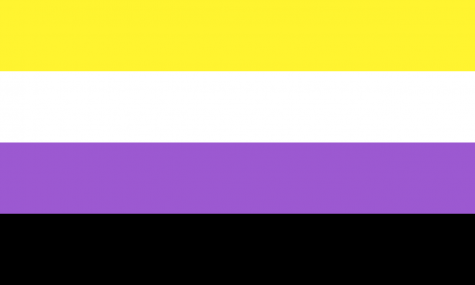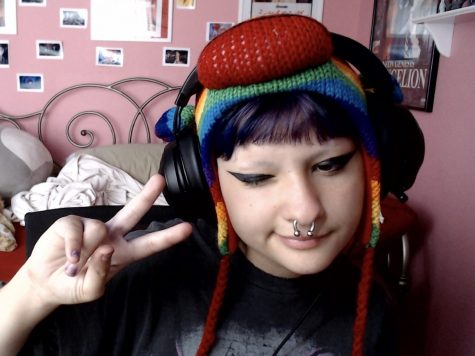Understanding Gender Identites

October 28, 2021
As time goes on, humans evolve and discover new ideologies, discover new words, new concepts, etc. One thing that has been developing for years and years is gender. First, let’s define gender and dig deep into its actual roots and meaning. According to Merriam-Webster, gender is defined as, “the behavioral, cultural, or psychological traits typically associated with one sex”. Often people like to think that sex and gender are the same terms when in reality they are not. Now let’s define sex, “either of the two major forms of individuals that occur in many species and that are distinguished respectively as female or male especially based on their reproductive organs and structures”, also defined by Merriam-Webster. Now comparing the two, sex refers strictly to biology, while gender is a social construct made up by humans. Note that the definition also says “typically associated with one sex”, meaning that not all the traits that are associated with one sex are exclusive to that sex. There has been a lot of controversy in this day and age where people like to claim there are only two genders when there’s a multitude of different genders, not only two. Not only is this false, because there are people born with both female and male reproductive organs/traits (intersex), as well as people can identify as a spectrum of genders. This is because people are confusing sex and gender. Gender can be perceived as a spectrum, and everyone’s gender identity slightly differs based on their upbringing and their life experiences, as well as a gut feeling. Understanding these concepts, and realizing that sex and gender are different is very important especially as we humans keep evolving.
 There’s probably no need to go over the difference between men and women because I’m sure everyone knows the difference between the two identities. A common term you will hear in the lgbtq+ community is transgender. Transgender people are people who have a different gender identity than what gender they were assigned at birth. For example, someone could be born with male reproductive organs, but they identify as a girl. People often like to say that being transgender is a form of mental illness, but it is not. They are probably thinking about mental disorders like body dysmorphia/gender dysphoria. Body dysmorphia is a disorder where you cannot stop obsessing over flaws in your appearance, where it can influence your daily lifestyle and mental health in general. Gender dysphoria is the disorder where someone feels discomfort or distress because their gender identity is different than the gender they were assigned at birth. However, these illnesses can be treated, either by therapy, surgery, etc. There is nothing wrong with having a different gender identity than what you were assigned at birth.
There’s probably no need to go over the difference between men and women because I’m sure everyone knows the difference between the two identities. A common term you will hear in the lgbtq+ community is transgender. Transgender people are people who have a different gender identity than what gender they were assigned at birth. For example, someone could be born with male reproductive organs, but they identify as a girl. People often like to say that being transgender is a form of mental illness, but it is not. They are probably thinking about mental disorders like body dysmorphia/gender dysphoria. Body dysmorphia is a disorder where you cannot stop obsessing over flaws in your appearance, where it can influence your daily lifestyle and mental health in general. Gender dysphoria is the disorder where someone feels discomfort or distress because their gender identity is different than the gender they were assigned at birth. However, these illnesses can be treated, either by therapy, surgery, etc. There is nothing wrong with having a different gender identity than what you were assigned at birth.
Now let’s go over the different identities. Think of gender as a spectrum, or a line. One end is boy (or male), and the other is a girl (or female). Most gender identities fall under this spectrum, between male and female. The most common gender identity label is cisgender, which means someone’s gender identity is the same as what gender they were assigned at birth. There is genderfluid, which means someone’s gender identity is unfixed, or changes over time, falling anywhere in the spectrum. This means they can feel like a girl one day, a boy the other, non-binary on another day. Non-binary is also common gender identity, meaning a gender identity that is outside of the binary (meaning male and female). Usually, non-binary people (aka enbies) don’t feel male or female. Agender is when someone does not identify as any gender. Some identities get more specific, like demi boy and demi girl, which are genders that only partially identify with the binary gender, but not wholly. Bigender is when someone identifies with both binary genders, male and female. There are other terms to help define trans people, like transmasculine (transmasc) and transfeminine (transfem) which are both umbrella terms for people who are trans (binary or non-binary) whose gender expression is more masculine or feminine. Remember that trans people do not owe anyone proper gender expression. This means that a trans woman does not owe you femininity, and a trans man does not owe you masculinity. Not everyone has the resources to present a certain way, or they simply feel one way and present themselves another. Anyone can identify as anything they please and can express themselves the way they choose.
 Now that you better understand the identities, let’s also go over pronouns, which is a hot topic of today’s society. Pronouns, in this context, are the preferred pronouns that an individual is referred to by in place of their proper name. As you probably know already, the pronouns we use in everyday life are gendered. Most people go by she/her/hers, and he/him/his. When you are talking about a group of people or someone of unspecified gender, you use they/them/theirs. There are also neopronouns, which are newer created pronouns that are used in place of the normal binary pronouns. Common neopronouns are xe/xem/xyr, per/pers, ve/ver. Usually, certain pronouns are associated or go along with certain genders. For example, she/her is associated with female, and he/him is associated with male. Most non-binary people prefer they/them. Although pronouns are associated with the binary, that doesn’t mean that someone with a masculine identity, or who presents masculine, cannot use female pronouns. Pronouns do not equal gender, meaning that any person who identifies or presents any way can use whatever pronouns they wish. A non-binary person can use he/him pronouns, a girl can use he/him pronouns, a boy can use she/her pronouns. There are endless possibilities of who can use what pronouns, and they are all valid.
Now that you better understand the identities, let’s also go over pronouns, which is a hot topic of today’s society. Pronouns, in this context, are the preferred pronouns that an individual is referred to by in place of their proper name. As you probably know already, the pronouns we use in everyday life are gendered. Most people go by she/her/hers, and he/him/his. When you are talking about a group of people or someone of unspecified gender, you use they/them/theirs. There are also neopronouns, which are newer created pronouns that are used in place of the normal binary pronouns. Common neopronouns are xe/xem/xyr, per/pers, ve/ver. Usually, certain pronouns are associated or go along with certain genders. For example, she/her is associated with female, and he/him is associated with male. Most non-binary people prefer they/them. Although pronouns are associated with the binary, that doesn’t mean that someone with a masculine identity, or who presents masculine, cannot use female pronouns. Pronouns do not equal gender, meaning that any person who identifies or presents any way can use whatever pronouns they wish. A non-binary person can use he/him pronouns, a girl can use he/him pronouns, a boy can use she/her pronouns. There are endless possibilities of who can use what pronouns, and they are all valid.
 To give you a different perspective, I will explain my experience as identifying as non-binary. My biological sex is female, but throughout my whole life, I’ve always struggled with feeling comfortable identifying with it. When I was young, I had a more husky voice, and never felt super feminine. After my mom stopped dressing me, I often didn’t dress very feminine, and I always favored more masculine or ungendered clothing. I didn’t like dresses, and I didn’t like makeup. Around the 5th grade, I decided to cut my hair short (something very unusual around that time). This created a very different feeling in my life, I felt like it suited me and my personality. I also had hit puberty, which was something that made me very uncomfortable, and I never really liked my chest, it made me feel super uncomfortable (quite frankly it still does to this day). I wasn’t very feminine, and I wasn’t very masculine either, I was just myself. Many times when I had short hair, I would get misgendered as a boy, which I found interesting. I also remember an instance in elementary school where someone had referred to me as a gender bender. My face wasn’t very feminine either, but it wasn’t extremely masculine. As I grew older, I just dressed as I pleased, which turned out to be a little more masculine than feminine. I also experience body dysmorphia so a lot of how I was dressed was to cater to that. Now, I realize that I don’t need to only wear masculine clothes. I wear both skirts and pants, and it has nothing to do with my gender identity, I just choose to express myself more androgynously. Only recently in the past year, have I started using binders, and learned about different identities. I had come to terms last summer that I identified with the non-binary gender, and came out to my friends and family, telling them that I prefer using they/them pronouns. I’m really glad that the internet helped me find how I identify, and now I feel a lot more at peace with my identity, although I do plan on getting top surgery one day in the near future.
To give you a different perspective, I will explain my experience as identifying as non-binary. My biological sex is female, but throughout my whole life, I’ve always struggled with feeling comfortable identifying with it. When I was young, I had a more husky voice, and never felt super feminine. After my mom stopped dressing me, I often didn’t dress very feminine, and I always favored more masculine or ungendered clothing. I didn’t like dresses, and I didn’t like makeup. Around the 5th grade, I decided to cut my hair short (something very unusual around that time). This created a very different feeling in my life, I felt like it suited me and my personality. I also had hit puberty, which was something that made me very uncomfortable, and I never really liked my chest, it made me feel super uncomfortable (quite frankly it still does to this day). I wasn’t very feminine, and I wasn’t very masculine either, I was just myself. Many times when I had short hair, I would get misgendered as a boy, which I found interesting. I also remember an instance in elementary school where someone had referred to me as a gender bender. My face wasn’t very feminine either, but it wasn’t extremely masculine. As I grew older, I just dressed as I pleased, which turned out to be a little more masculine than feminine. I also experience body dysmorphia so a lot of how I was dressed was to cater to that. Now, I realize that I don’t need to only wear masculine clothes. I wear both skirts and pants, and it has nothing to do with my gender identity, I just choose to express myself more androgynously. Only recently in the past year, have I started using binders, and learned about different identities. I had come to terms last summer that I identified with the non-binary gender, and came out to my friends and family, telling them that I prefer using they/them pronouns. I’m really glad that the internet helped me find how I identify, and now I feel a lot more at peace with my identity, although I do plan on getting top surgery one day in the near future.












Teresa Buelna • Nov 11, 2021 at 8:11 am
We are so incredibly proud of the AMAZING EXPRESSIVE person that you are, have always been, and will always be. The world is lucky to have you in it.